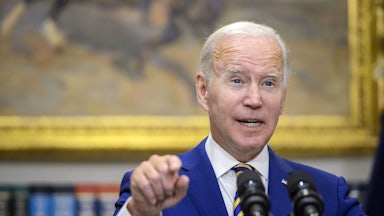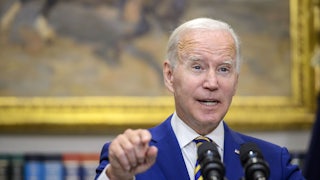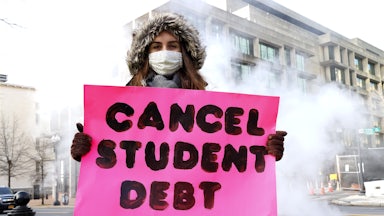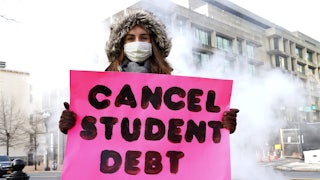On Wednesday, President Biden announced that he would use his executive power to wipe out up to $10,000 in student loans for 43 million Americans, and up to $20,000 for those who received Pell Grants to attend college. A decade ago, if you had told me that Joe Biden, a man who during his long career as senator helped expand the student lending industry and worked to strip student borrowers of bankruptcy protections, would one day be president and eliminate hundreds of billions of dollars of student debt, I would have scoffed—even as I was throwing my lot in with the movement that would fight doggedly to make this happen.
Make no mistake about it, this represents a landmark victory for student debtors. Through years of tireless and often thankless organizing, borrowers and their allies pushed a reluctant administration to deliver broad-based student debt cancellation—to bail out regular people, not big banks or businesses. Approximately 20 million people will have their balances completely wiped out, and many have been sharing emotional messages of shock and jubilation online.
Yet the triumph is bittersweet. For millions of others, including most members of the Debt Collective—the union for debtors I helped found—$10,000 or even $20,000 doesn’t begin to chip away at the interest that has capitalized on their balance sheets, and it won’t reduce their monthly payments. Experts warn that many won’t get the relief they are entitled to due to the application process that attends the income cap. As one older debtor who owes over six figures told me, the plan is a “coupon that’s not worth clipping.” The NAACP tweeted a similar sentiment: “Canceling $10,000 of student debt after ‘considering’ it for more than a year and a half is like waiting on hold for 6 hours only to get a 5% refund.” The low dollar amount and unnecessary bureaucratic hoops—and the fact that the application is not yet available to borrowers—makes me worry the policy might wind up being less popular, and thus less of a win for Democrats, than it would have been if more generous cancellation was granted automatically.
In the weeks and months ahead, we need to ensure that debtors are able to access the relief they are entitled to. And we need to defend this policy decision from bad-faith critics. Republicans such as Trump’s billionaire Education Secretary Betsy DeVos, Senator Mitch McConnell, and Clinton-era economists such as Jason Furman and Larry Summers are all peddling debunked claims that debt cancellation is a handout to the privileged that will grow the deficit and fuel inflation (even the notorious socialists at Goldman Sachs have debunked these claims, and the Nobel Prize–winning economist Joseph Stiglitz has said it may well reduce inflation). Finally, we need to ensure that this announcement is a stepping stone, not a destination—a milestone on the path to full student debt abolition and an overhaul of our higher education system, including making public college free for all who want to attend.
I believe that this is possible because I’ve seen what it took to get to this point. Over 10 long years, a growing coalition of debtors, lawyers, policy wonks, racial justice advocates, labor unions, and progressive public officials have pushed the demand for loan cancellation from the political margins to the mainstream. The Debt Collective, in particular, expanded the Overton window through bold tactics, including multiple successful debt strikes. Despite the overwhelming stigma and judgment associated with indebtedness in this country, debtors from all walks of life went public with their financial struggles, said “enough is enough,” and got organized. They signed petitions, disputed their debts, attended protests, and declared their inability and unwillingness to pay—and, against the odds, completely shifted the coordinates of the debate and, as of this week, secured hundreds of billions of dollars in relief. In a rare acknowledgment of the critical role of bottom-up mobilizing, former President Obama tweeted that the news was a “testament” to “all the activists who’ve been calling for student debt relief for years.”
It’s easy to forget just how quixotic the demand for student debt cancellation seemed when it first rang out during Occupy Wall Street a decade ago, back when Obama was president. On April 8, 2012, members of the short-lived Occupy Student Debt Campaign organized a protest dubbed 1T Day, marking the day student debt surpassed $1 trillion. Protesters dressed in caps and gowns made of black trash bags and demanded a student loan jubilee. Media coverage was scant and dismissive. “They want all student debt in the country forgiven. All $1 trillion of it. And if the government would be so kind, they’d appreciate it if it would pay for higher education from here on out, as well,” Reuters’s Chadwick Matlin jeered. “What has happened to this proposal? Hardly anybody has cared.” According to NPR’s All Things Considered, “Most experts believe there’s little chance the government would ever forgive student loans.”
Unlike the skeptics, my fellow occupiers and I didn’t see 1T Day’s demands as particularly extreme. The government, after all, had just bailed out the banks after they tanked the global economy and screwed over millions of homeowners, including my parents, whose house was underwater. At the time I was a recent student loan defaulter (though I eventually paid off the loan in full—or rather, my partner paid it for me, a liberation I want everyone else to experience). Why shouldn’t former students like myself, who only did what they were told by pursuing postsecondary degrees to get ahead, also get a helping hand? All my peers and I wanted was what previous generations had enjoyed: a chance to pursue higher learning debt-free.
With this goal in mind, we formed working groups to learn more about the mechanisms of our highly financialized economy and began hosting what we called “debtors’ assemblies,” heartrending forums where strangers shared their financial woes. To visit an Occupy encampment was to be surrounded by people behind on rent, mortgage payments, medical and credit card bills, and student loans. Through conversation and confession, our shame about being in debt began to dissolve; we started to see our indebtedness not as a personal failing but as the product of a failed system: one in which low wages, inadequate public services, systemic racism and sexism, and profiteering conspire to force the majority of us to borrow to meet our basic needs. To call attention to these dynamics and to help debtors in need, we raised crowdfunded donations and began purchasing portfolios of unsecured debt on the secondary markets, erasing tens of millions of dollars of medical bills and payday loans for tens of thousands of people across the country. We called this grassroots bailout of the people, by the people, the Rolling Jubilee.
Of course, we knew we would never be able to purchase and erase all of the debt sloshing around, but I wasn’t entirely clear on next steps. One afternoon, I expressed my reservations to my collaborators while we were filming an agitprop video that involved various people, including the artist Thomas Gokey and the late anthropologist David Graeber—author of the unlikely 2011 blockbuster Debt: The First 5,000 Years—dancing around a trash can at dusk burning fake debt notices while wearing balaclavas. “What we need,” Gokey responded, having clearly thought the question through, “is a debtors union.” I felt as though a cartoon light bulb went off over my head. Just as workers come together to fight for better wages and benefits, debtors needed to get organized in order to fight for relief and changes to public policy. If we got organized, perhaps we could turn our isolating obligations into a source of shared leverage to demand change.
Two years later, the Debt Collective was officially launched when we announced the country’s first student debt strike. Fifteen students—Nathan Hornes, Latonya Suggs, Ann Bowers, Jessica Madison, and others—who had been defrauded by the collapsing for-profit chain Corinthian Colleges, went public, refusing to pay back their loans and demanding full cancellation from the Education Department. The Corinthian 15 caught on in the media and even inspired an episode of the popular television show The Good Wife.
Laura Hanna and Ann Larson were the campaign’s stalwart organizers and brilliant strategists, crisscrossing the country meeting former Corinthian students, whose striking ranks swelled; Wall Street defector turned policy wonk Alexis Goldstein helped us navigate Washington D.C.; law school student Luke Herrine connected us to brilliant lawyers, including Eileen Connor, Toby Merrill, Robyn Smith, and Deanne Loonin. Their work on predatory student lending included powerful but underappreciated arguments about the Department of Education’s various authorities to cancel federal student loans, including a little-known provision called Borrower Defense to Repayment, which says loans must be canceled when institutions mislead students or violate state law—standard-issue fare for for-profit schools like Corinthian. With their help, we created a mobile-friendly website that allowed us to flood the department with Defense to Repayment claims and forced the Obama administration to begin issuing a trickle of relief.
The Corinthian campaign showed that debt cancellation was possible (even if it would take seven years for our full demands to be met: In June this year, the Biden administration finally granted the automatic mass discharge the Corinthian strikers called for, amounting to nearly $6 billion for over half a million people). In early 2020, Senator Elizabeth Warren, inspired by the Corinthian example, made broad student debt relief a central plank of her presidential primary run, followed by Bernie Sanders. Boxed in, Mr. Biden reluctantly embraced student loan cancellation as well.
The wild card was Covid-19. The world-shaking pandemic got President Trump to pause payments for the vast majority of federal student loan borrowers. Tens of millions of people got accustomed to not making monthly payments, and the experience showed that the federal government could function just fine without student loan revenue. Around the same time, the protests catalyzed by the murder of George Floyd primed people to better understand the structural inequities built into our debt-financed system of higher education, which leaves Black borrowers, particularly Black women, with the highest debt loads, making debt cancellation a clear matter of racial and gender justice. By the time President Biden took office, a diverse and growing coalition of grassroots activists and civil society groups were committed to ensuring he delivered on his promise.
With the student loan moratorium now extended to January 1, 2023, this coalition must work to ensure payments never get turned on again. To that end, thousands of people have signed up pledging to go on debt strike should the administration attempt to restart the collection system, committing to a path of noncompliance and nonpayment. A significant subset of these strikers are in their sixties, seventies, and even eighties. Contrary to the stereotype of young, upwardly mobile borrowers, senior citizens are the fastest growing demographic of student debtors, and some of the most desperate. The loans they took out in hopes of achieving economic security in old age are plunging them into deeper poverty and precarity.
In my 10 years in the trenches of debt abolition, I’ve heard more jokes about dying in debt than I care to count—indeed, the typical American ends life in the red, owing an average of $62,000. I’ve met people who postponed retirement because they took out Parent Plus loans to help their children, Black mothers crushed by debt because they pursued higher education without family wealth to draw on, college dropouts saddled with debt without the benefit of a degree, dedicated teachers and nurses who owe more than $100,000 yet aren’t eligible for existing Public Service Loan Forgiveness programs. I’ve cried as people opened up about the psychological stress of their debt and told me they considered suicide as the only viable way out. I’ve seen Debt Collective members endure poverty, homelessness, and worse as a result of the Department of Education’s arcane and dysfunctional bureaucracy. While waiting for a refund of her illegal wage garnishments, Jessica Madison, one of the original Corinthian 15 strikers, was unable to afford proper medical care and died of cancer.
This is why the Debt Collective refuses to use the phrase “debt forgiveness.” Borrowers are not to blame. The problem is our broken economic and educational system, which indebts people by design, ensnaring millions in traps made of capitalizing interest and corrupting the Department of Education by turning it into a predatory lender. It makes no sense to speak of forgiveness for those who have paid many times the original principal, or who had to borrow for college because their families lacked the wealth to pay for tuition up front.
I’m glad President Biden has canceled some student debt. I wish he had canceled much more. What happens next is a question of both morality and math. This country’s debtors will never be able to pay off the growing mountain of student debt that failed policies have forced them to amass. From today’s vantage point, $1T Day seems quaint. Even after this week’s landmark announcement, best estimates put student debt at around $1.7 trillion, and that number will swiftly tick back up.
But here’s the thing. This debt doesn’t need to exist, and at long last, everyone finally knows that to be true. The American people will never see student debt in the same way again. If the president can cancel $10,000, he can cancel it all. And if we continue to keep organizing, one day someone will.










